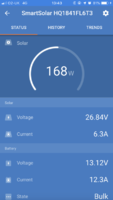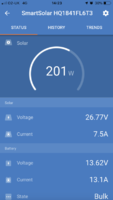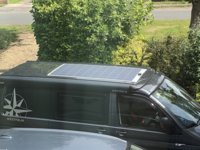Thanks Andy appreciate detailed reptHi Phil, the panel I have is the one @Deaky fitted and I would definitely recommend it, the only thing I'd change is that I would also go for the version that had the connections underneath as fitted by him, it would be better cosmetically, especially in my case with it being at the front. The problem was, as you mention, it was out of stock with no definite delivery date available when I bought. But this is a screenshot a few minutes ago, and the roof isn't even angled towards the sun!
View attachment 28126
Note that it's pegged at 10A though, I should have gone for the 75/15 but it was out of stock and I went for the 75/10. Very happy with the setup though, I haven't even brought a hookup cable with me and I don't even have to think about my electricity use. Totally addicted to checking the victron app though
You are using an out of date browser. It may not display this or other websites correctly.
You should upgrade or use an alternative browser.
You should upgrade or use an alternative browser.
P
Phil_G
Guest
Andy, you dont absolutely need 6mm² cable from the panel to the controller, 4mm² is plenty and far more flexible.Yes I used 6mm cable, it’s stiff as hell and I found it quite difficult to route as it needs quite a large bending radius. Getting the right position for the cables to bend with the roof was one of the hardest jobs for me.
This particlular 250w panel we're talking about has an internal resistance of 4.47 ohms. Three metres of 6mm² cable has a resistance of 18 milliohms, and 3 metres of 4mm² has a resistance of 25 milliohms. Over a three metre length the difference from 6mm² to 4mm² is only seven milliohms and this is in series with a panel having a resistance of four-thousand, fourhundred and seventy milliohms. The panel resistance is so many orders of magnitude above the cable that 6mm² or 4mm² makes almost no difference at all. Its not about voltage drops either, the panel is dropping 6.4v internally (Voc-Vmp) and at its absolute maximum of 8 amps the tiny cable drop difference (0.14v for 6mm² vs 0.2v for 4mm², difference point zero-six of a volt) is simply compensated by the mpp tracking at the controller.
Just to emphasize the perspective, point zero-six is less than one-percent of the panels internal voltdrop!
The higher power panels generally have more cells in series for a higher terminal voltage, the current is about the same so there is no real reason to use 6mm for 250w and 4mm for a 150w panel. The cable is unaware of the source voltage, only the current its carrying.
Increasing the cable guage would only make sense for paralleled panels - which this one isnt
I'm kind of reluctant to post this as its been contentious in the past but really, its just simple maths

Cheers
Phil
[Light the blue touchpaper and retire immediately...]
Last edited by a moderator:
Thanks Phil, I appreciate the detailed analysis and I'm sure you're right, but it came ready attached to the panel and there was no way of undoing the connection on the panel so I was stuck with it. I wanted to feed both cables through one hole but it was so stiff it wouldn't bend enough so I had to drill two separate holesAndy, you dont need 6mm² cable from the panel to the controller, 4mm² is plenty and far more flexible.
This particlular 250w panel we're talking about has an internal resistance of 4.47 ohms. Three metres of 6mm² cable has a resistance of 18 milliohms, and 3 metres of 4mm² has a resistance of 25 milliohms. Over a three metre length the difference from 6m² to 4mm² is only seven milliohms and this is in series with a panel having a resistance of four-thousand, fourhundred and seventy milliohms. The panel resistance is so many orders of magnitude above the cable that 6mm² or 4mm² makes almost no difference at all. Its not about voltage drops either, the panel is dropping 6.4v internally (Voc-Vmp) and at its absolute maximum of 8 amps the tiny cable drop difference (0.14v for 6mm² vs 0.2v for 4mm², difference point zero-six of a volt) is simply compensated by the mpp tracking at the controller.
Just to emphasize the perspective, point zero-six is less than one-percent of the panels internal voltdrop!
The higher power panels generally have more cells in series for a higher terminal voltage, the current is about the same so there is no real reason to use 6mm for 250w and 4mm for a 150w panel. The cable is unaware of the source voltage, only the current its carrying.
I'm kind of reluctant to post this as its been contentious in the past but really, its just simple maths
Cheers
Phil
[Light the blue touchpaper and retire immediately...]
P
Phil_G
Guest
The very thought of drilling holes in your pride & joy makes you cringe eh  Worth it though.
Worth it though. 
Incidentally silicone cable is very flexible, floppy even. It relieves a lot of physical stress points too


Incidentally silicone cable is very flexible, floppy even. It relieves a lot of physical stress points too

Now back home after an enjoyable couple of weeks and the solar installation was a huge success! I gambled and didn't even take a hookup lead so I could use the space for other things and didn't miss it at all. At one stage I spent 5 days without starting the engine, admittedly in sunny weather but very rarely full sun, and the battery was above 13v every night I settled down to sleep. I didn't get near the 250W, the highest I saw was 145W, but I imagine you would have to have clear, strong sunlight to all sections of the panel, and also have the van angle and roof elevation spot on to see that.
Not as much as burning two holes in the front of the canvasThe very thought of drilling holes in your pride & joy makes you cringe eh
No, none, so yet to be tested on that score.how did the installation fair up? you had not much rain i guess?
I thought I'd admit to a dumb realisation in case anyone else thinks what I thought and now will never have to say 
Since getting the panel and Victron controller I've always thought that the main Watts display was purely a measure of how much power the panel is receiving from the sun. Today though, I had the van out for a post-holiday thorough clean, and happened to look at the app and saw that it was only getting 3W. It was a bright sunny day and I was taken aback by how much weaker the autumn sun must be so put the roof up, tilted directly at the sun - 4W. Then I put the LED lights on - 12W, then the rear ones as well - 16W.
I was starting to get a clue here and switched the fridge and water heater on - BOOM 145W!
So I now realise the power displayed is the output to the battery, not just a measure of how bright the sun is. The reason it was only 3W initially was that the battery was at float level with no demands on it. I'm sure most people realised this, but I didn't
Since getting the panel and Victron controller I've always thought that the main Watts display was purely a measure of how much power the panel is receiving from the sun. Today though, I had the van out for a post-holiday thorough clean, and happened to look at the app and saw that it was only getting 3W. It was a bright sunny day and I was taken aback by how much weaker the autumn sun must be so put the roof up, tilted directly at the sun - 4W. Then I put the LED lights on - 12W, then the rear ones as well - 16W.
I was starting to get a clue here and switched the fridge and water heater on - BOOM 145W!
So I now realise the power displayed is the output to the battery, not just a measure of how bright the sun is. The reason it was only 3W initially was that the battery was at float level with no demands on it. I'm sure most people realised this, but I didn't

P
Phil_G
Guest
Thats right Andy, its all down to 'demand' 
The 'poor weather' output of the Photonic Universe panel has surprised me, useful output in dull, overcast skies, when my cheap nasty panels have shut down
Cheers
Phil
The 'poor weather' output of the Photonic Universe panel has surprised me, useful output in dull, overcast skies, when my cheap nasty panels have shut down
Cheers
Phil
Last edited by a moderator:
I thought I'd admit to a dumb realisation in case anyone else thinks what I thought and now will never have to say
Since getting the panel and Victron controller I've always thought that the main Watts display was purely a measure of how much power the panel is receiving from the sun. Today though, I had the van out for a post-holiday thorough clean, and happened to look at the app and saw that it was only getting 3W. It was a bright sunny day and I was taken aback by how much weaker the autumn sun must be so put the roof up, tilted directly at the sun - 4W. Then I put the LED lights on - 12W, then the rear ones as well - 16W.
I was starting to get a clue here and switched the fridge and water heater on - BOOM 145W!
So I now realise the power displayed is the output to the battery, not just a measure of how bright the sun is. The reason it was only 3W initially was that the battery was at float level with no demands on it. I'm sure most people realised this, but I didn't
Hi Andy. New to the forum, so thanks for sharing all this. Really useful. I've been looking at the CTEK 250SE for my leisure battery/solar set up as a simpler option. I've also got an EPever MPPT charge controller but was thinking of selling it on and just attaching the panel to the CTEK.
As I know you know (!) the CTEK has an integrated MPPT, so you can plug the panel straight into it. So is there an advantage in connecting the panels to the EPever controller (and then to the battery) instead of simply connecting the panels direct to the CTEK? Is there a reason you chose to attach the Victron instead of just going directly to the CTEK?
Cheers!
Pete
@Pjm24
His new panel exceeded the max voltage VOC of the CTEK unit (CTEK 22v max i think)
so the Victron could handle the larger panel and higher VOC and work in tandem with the CTEK at keeping the Leisure battery charged.
The only downside was that he lost the ability to reverse trickle charge the starter battery (via the CTEK)
so to get around that issue is believe he fitted a Votronic B2B trickle charger to trickle charge (back feed) thae starter battery,
more info here:
***************************

 www.t6forum.com
www.t6forum.com

 www.t6forum.com
www.t6forum.com

 www.t6forum.com
www.t6forum.com
Mobile Solar Panels ? . . . - How I Did It -
What Solar Panel & Controller ?
**************************************************
Dellmassive`s -- "how I Done It" -- Thread
**************************************************
Kit List And Stuff -- How I Done It & What I Use --
**************************************************
His new panel exceeded the max voltage VOC of the CTEK unit (CTEK 22v max i think)
so the Victron could handle the larger panel and higher VOC and work in tandem with the CTEK at keeping the Leisure battery charged.
The only downside was that he lost the ability to reverse trickle charge the starter battery (via the CTEK)
so to get around that issue is believe he fitted a Votronic B2B trickle charger to trickle charge (back feed) thae starter battery,
more info here:
***************************

[Guide] DC-DC Charger (for leisure battery) -- How I Done It --
DC-DC Charger (for Leisure battery) -- How I Done It -- ************************************************** Dellmassive`s -- "how I Done It" -- Thread ************************************************** Kit List And Stuff -- How I Done It & What I Use --...

Battery Monitoring -- How I Done It --
Battery Monitoring -- How I Done It -- Part #1 Battery monitoring is a very important part of your 12v system . . . . whether its just the vans starter battery or your leisure setup keeping an eye on the power in your battery bank will keep you from breaking down and make sure your weekends...

Solar PWM & MPPT Controllers - How I Done It -
Solar PWM & MPPT controllers - How I Done It - There is a lot of talk about Solar at the moment, and with spring not to far away i wanted to go over the whole Solar controller thing. The main components are the Panels themselves, the charge controller (whether that be stand alone or...
Mobile Solar Panels ? . . . - How I Did It -
What Solar Panel & Controller ?
**************************************************
Dellmassive`s -- "how I Done It" -- Thread
**************************************************
Kit List And Stuff -- How I Done It & What I Use --
**************************************************
Similar threads
- Replies
- 1
- Views
- 326
- Replies
- 1
- Views
- 430
- Replies
- 1
- Views
- 262
- Replies
- 5
- Views
- 1K
- Replies
- 2
- Views
- 925




